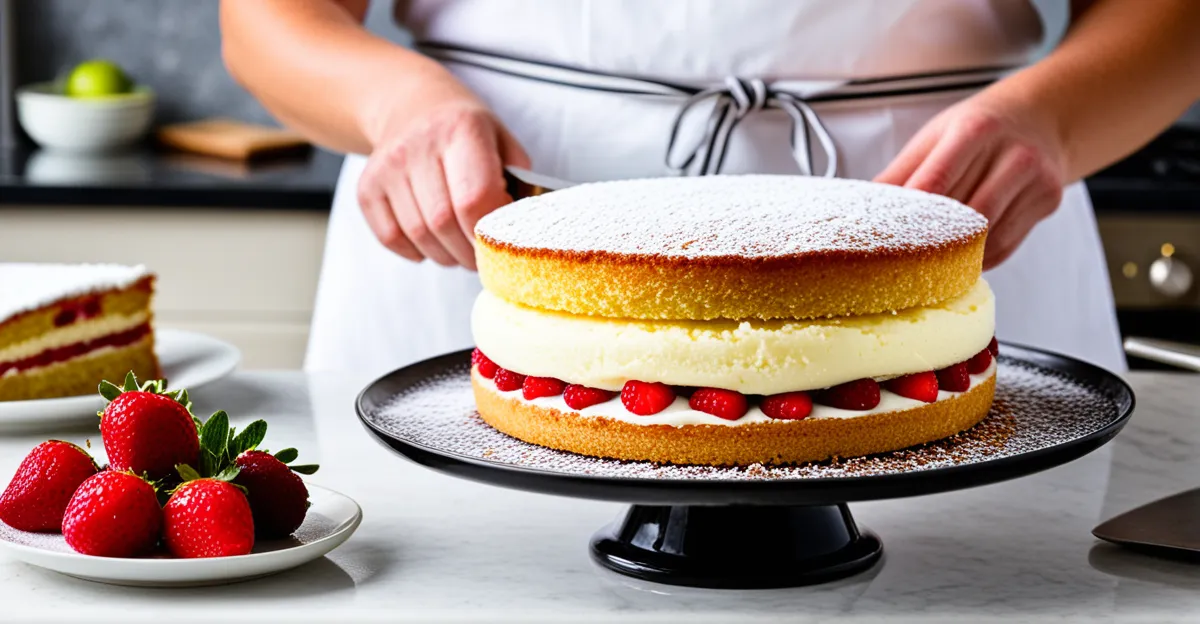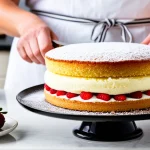Essential Ingredients and Required Equipment
Knowing the right Victoria sponge cake ingredients and having the proper baking equipment are critical for achieving the classic cake’s perfect texture and flavor. Precision in measurements is key: traditional recipes call for equal weights of butter, caster sugar, eggs, and self-raising flour. This balance ensures the cake rises evenly and maintains a tender crumb.
Quality ingredients elevate the result. Use fresh, unsalted butter, free-range eggs, and sifted flour to remove lumps and incorporate air. Proper preparation, such as bringing ingredients to room temperature, helps the mixture blend smoothly.
Additional reading : What Are the Most Popular UK Dishes Across Different Regions?
Recommended baking equipment includes a reliable set of scales for precise ingredient measurement, two matching 8-inch round cake tins for uniform layers, and an electric mixer to cream butter and sugar effectively. A sieve is useful for aerating dry ingredients, and an oven thermometer guarantees accurate baking temperatures.
Attention to these essential ingredients and tools forms the foundation of a classic cake recipe that’s as delicious as it is timeless.
Have you seen this : How can you prepare a traditional English ploughman’s lunch?
Step-by-Step Baking Instructions
Master the art of Victoria sponge with precise steps
To understand how to bake Victoria sponge perfectly, start by creaming the butter and sugar until the mixture is pale and fluffy. This aeration is critical for the classic cake recipe’s light texture. Use an electric mixer on medium speed, which helps incorporate air efficiently without overworking the butter.
Next, gradually add beaten eggs to the creamed mixture while mixing continuously. This timing prevents curdling and ensures a smooth batter. When incorporating the flour, fold it gently using a spatula to retain air, avoiding mixing that can deflate the batter.
Baking requires an accurate oven temperature—typically 180°C (350°F)—to allow proper rising without overbaking. Set a timer for 20 to 25 minutes but also look for visual cues like a golden-brown surface and a springy texture when pressed lightly.
Following this step-by-step guide ensures your cake baking process yields moist, evenly risen layers that make an ideal Victoria sponge.
Classic Fillings and Assembly Tips
Perfect the art of assembling your Victoria sponge
A traditional Victoria sponge filling pairs light whipped cream with fruity jam, commonly raspberry or strawberry. This classic combination balances sweet and tart, complementing the soft sponge layers perfectly. For a reliable result, whip the cream just until soft peaks form—overwhipping can turn it grainy.
When applying the filling, start by spreading a thin layer of jam evenly over one cake layer. Then dollop whipped cream on top and spread gently to avoid mixing the layers. This method maintains the cake’s delicate texture and prevents sogginess.
Stacking requires precision. Place the second sponge layer carefully on top to avoid cracking. For even stacking, ensure both cake layers are level by trimming any dome tops before assembly.
Presentation matters. A dusting of caster sugar or an extra swirl of cream can make a simple sponge look elegant. Properly executed Victoria sponge filling and assembly elevate the cake from homemade to truly classic, delicious perfection.
Troubleshooting and Success Tips
How to conquer common hurdles when baking your Victoria sponge
Understanding the most frequent Victoria sponge cake tips can greatly improve your baking outcomes. One of the usual mistakes is overmixing the batter, which can lead to a dense, tough texture rather than the classic light crumb. To avoid this, mix ingredients just until combined.
If your cake sinks in the middle, it’s often due to underbaking or opening the oven door too early, causing a sudden temperature drop. Make sure to bake at the recommended 180°C (350°F) and resist peeking before the 20-minute mark.
Dry cakes often result from overbaking or too much flour. Using exact Victoria sponge cake ingredients proportions and checking doneness promptly can prevent this. Keeping the cake fresh is crucial: wrap cooled layers in cling film or store in an airtight container.
By recognizing these common cake troubleshooting issues and applying these solutions, you ensure your classic cake recipe turns out perfectly light, moist, and delicious every time.
Frequently Asked Questions and Variations
Bring creativity and clarity to your Victoria sponge experience
What is the best way to store a Victoria sponge cake? Store your cake in an airtight container at room temperature to maintain moisture for up to two days. Refrigeration can dry out the sponge unless tightly wrapped, which slows freshness loss but may affect texture.
Can I adapt the classic cake recipe for dietary needs? Absolutely. For gluten-free options, substitute self-raising flour with a gluten-free blend. Egg replacements like applesauce or flaxseed mixtures work for vegan diets, but texture may vary slightly.
How can I introduce variations without losing the cake’s traditional charm? Add lemon zest to the batter for a citrus twist or swap raspberry jam for apricot or blackberry to diversify flavors. Lightly fold in fresh berries to the cream for extra freshness and visual appeal.
Exploring Victoria sponge FAQs encourages experimentation while respecting the classic qualities. These thoughtful adjustments ensure your baking remains both traditional and delightfully personal.






